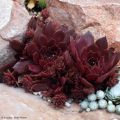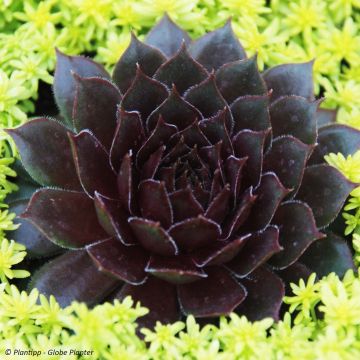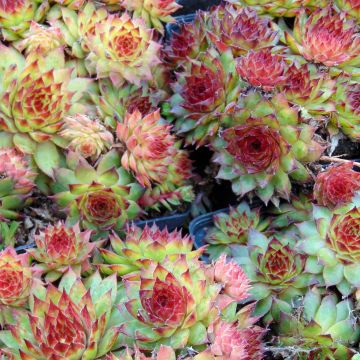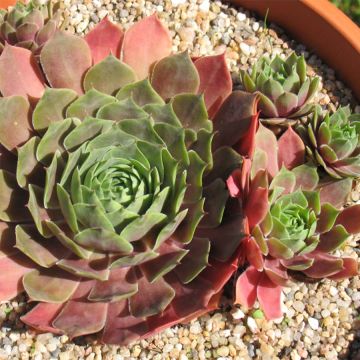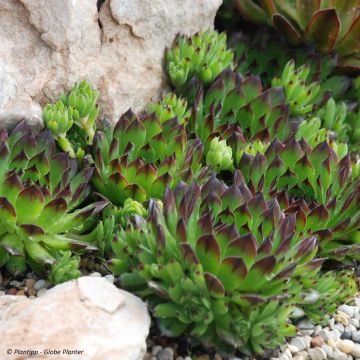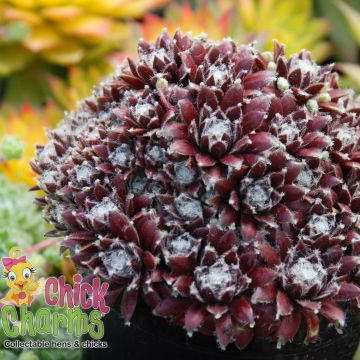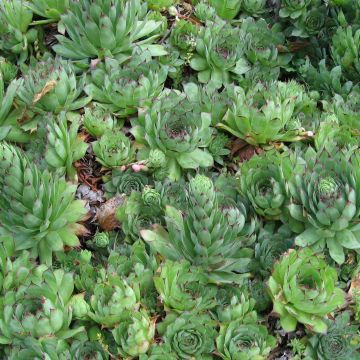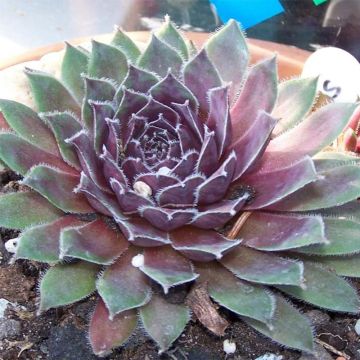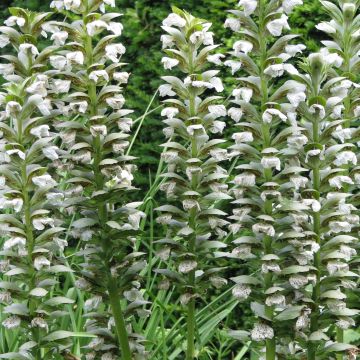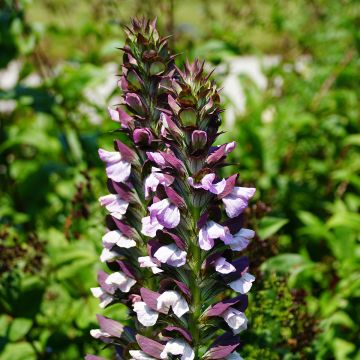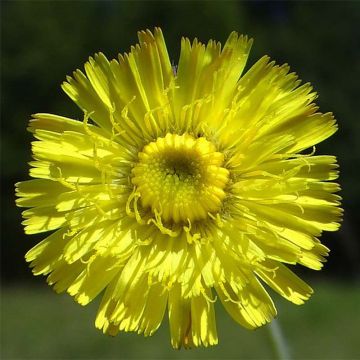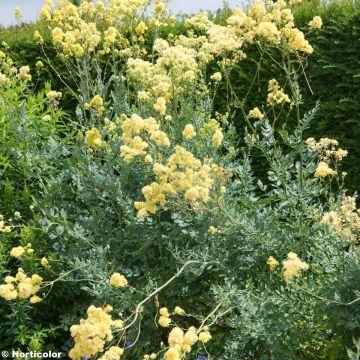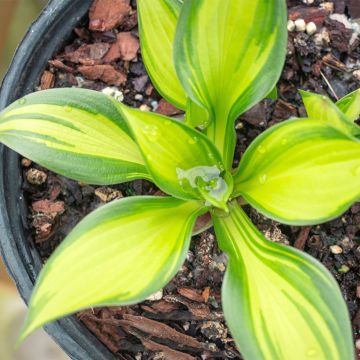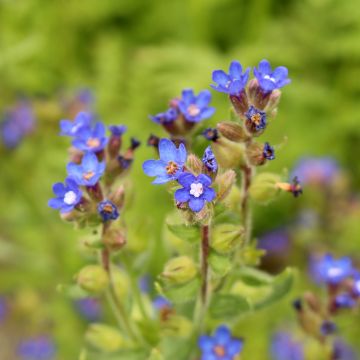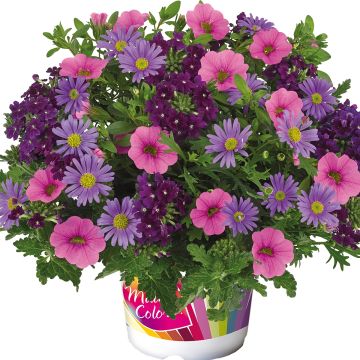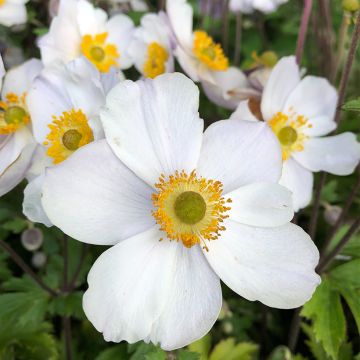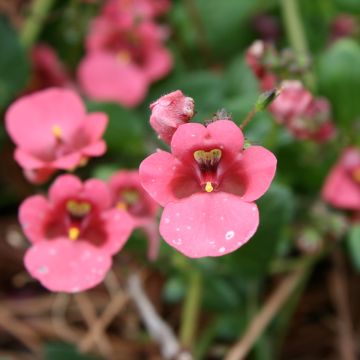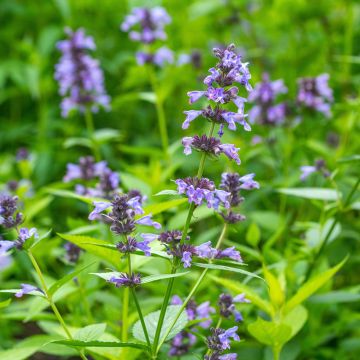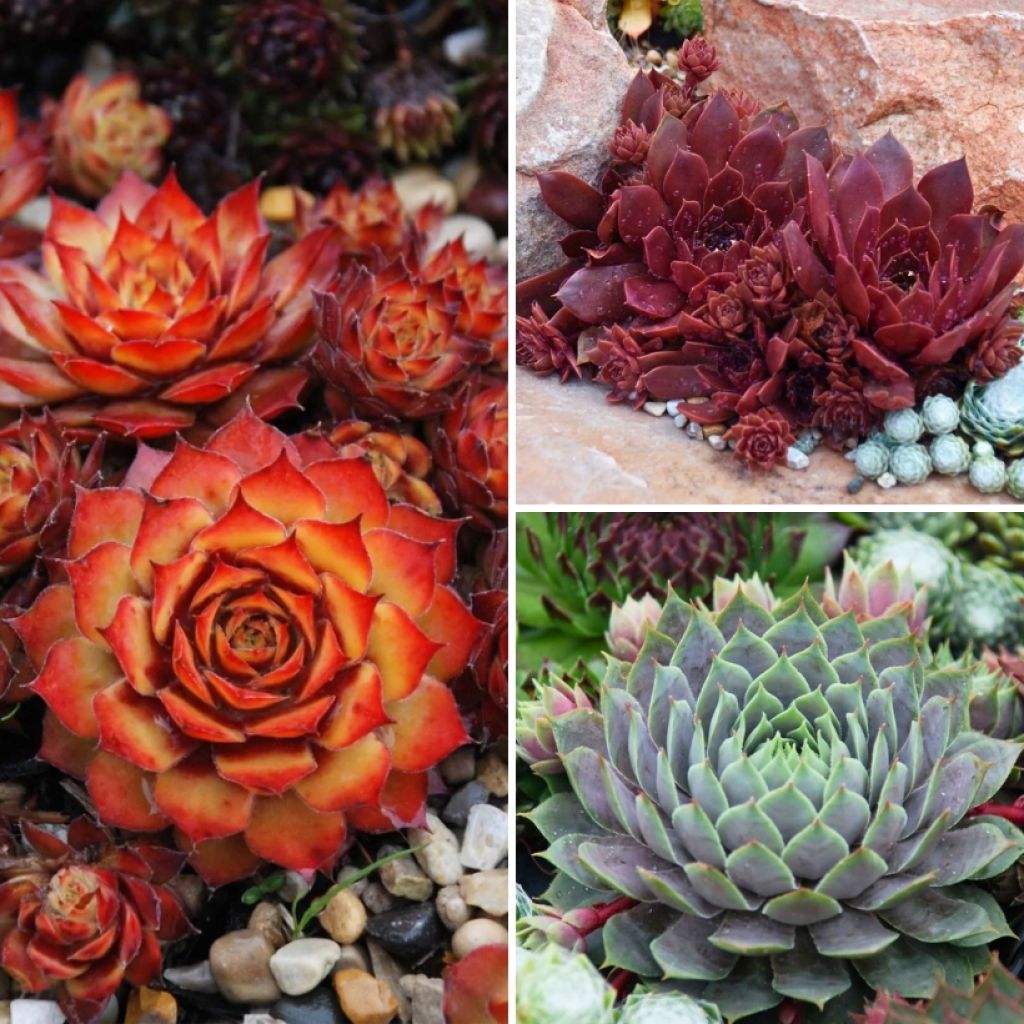

Sempervivum Collection - Houseleek
Sempervivum Collection - Houseleek
Sempervivum Chick Charms® Berry Blues, Chick Charms® Chocolate Kiss, Chick Charms® Gold Nugget
Houseleek, Hen and Chicks
This item cannot be shipped to the selected country
Delivery charge from €5.90
More information
Schedule delivery date,
and select date in basket
This plant carries a 12 months recovery warranty
More information
We guarantee the quality of our plants for a full growing cycle, and will replace at our expense any plant that fails to recover under normal climatic and planting conditions.
From €5.90 for pickup delivery and €6.90 for home delivery
Express home delivery from €8.90.
Does this plant fit my garden?
Set up your Plantfit profile →
Collection items (3 plants)
Description
This Chick Charms® houseleek collection brings together three varieties of remarkably colourful Sempervivum. These small hardy perennial plants charm with their resilience and sculptural appeal. They offer persistent foliage in rosettes ranging from blue-green to red and yellow, with colours evolving throughout the seasons. Well-suited to well-drained soils and very sunny exposures, these houseleeks are ideal for embellishing rock gardens, walls, or even in pots on a terrace. Easy to cultivate, they tolerate drought and withstand cold down to -20°C.
The collection consists of:
1 x Sempervivum Chick Charms® 'Berry Blues': its large rosettes are formed of long incurved leaves that gradually change from grey-blue to mauve purple under the influence of cold in autumn and winter. Its pink to purple flowering, with small discreet stars, occurs in summer, on rosettes aged 2 to 3 years.
1 x Sempervivum Chick Charms® 'Chocolate Kiss': its beautifully sized rosettes are made up of wide, glossy leaves in a rich, deep chocolate purple. It flowers with small pink stars in summer.
1 x Sempervivum Chick Charms® 'Gold Nugget': this variety boasts a unique colour, its rosettes are formed of fleshy leaves that are bright green in summer, turning golden with bright red-orange tips in autumn, a reddish-orange hue that intensifies in winter. Summer flowering with small pink flowers.
The houseleek requires no maintenance; it spreads spontaneously by producing numerous offsets, forming extraordinary sculptural mats in the sun. It is hardy and thrives in dry, poor, siliceous or calcareous soil, relying on rainwater, even if it is scarce. The Sempervivums in this collection are ideally planted in spring or autumn, in full sun, in a rockery, a raised border, above a wall, or in a large pot. Position 'Gold Nugget' in the centre to draw the eye with its changing colours, framed by 'Berry Blues' and 'Chocolate Kiss'. Plant them 15 cm apart. Allow for approximately 12 plants per m² for a dense mat.
Pair these houseleeks with perennial plants that share the same soil and exposure needs. Creeping Sedums, such as Sedum spathulifolium 'Cape Blanco', and Delospermas, such as Delosperma 'Wheels of Wonder White' with pure white flowers, will make lovely companions.
Report an error about the product description
Flowering
Foliage
Plant habit
Botanical data
Sempervivum
Chick Charms® Berry Blues, Chick Charms® Chocolate Kiss, Chick Charms® Gold Nugget
Crassulaceae
Houseleek, Hen and Chicks
Cultivar or hybrid
Other Sempervivum - Houseleek
Planting and care
Sempervivum (Chick Charms Series) thrives in sunny to partially shaded locations and in perfectly drained, damp to dry, poor soil that does not retain water. You can plant it in spring or autumn, either in the ground or in a container, adding gravel or coarse sand to the planting substrate. Conversely, if you place it in a rock garden or on a wall, simply provide a little potting compost to help it establish. After that, it will manage on its own.
If you wish to propagate it, simply cut a few juvenile rosettes and replant them elsewhere, barely burying the roots. Care for it by ensuring it is not overshadowed by taller plants, does not become covered in dead leaves or plant debris, and by removing any faded small inflorescences.
Planting period
Intended location
Care
This item has not been reviewed yet - be the first to leave a review about it.
Summer flowering perennials
Haven't found what you were looking for?
Hardiness is the lowest winter temperature a plant can endure without suffering serious damage or even dying. However, hardiness is affected by location (a sheltered area, such as a patio), protection (winter cover) and soil type (hardiness is improved by well-drained soil).

Photo Sharing Terms & Conditions
In order to encourage gardeners to interact and share their experiences, Promesse de fleurs offers various media enabling content to be uploaded onto its Site - in particular via the ‘Photo sharing’ module.
The User agrees to refrain from:
- Posting any content that is illegal, prejudicial, insulting, racist, inciteful to hatred, revisionist, contrary to public decency, that infringes on privacy or on the privacy rights of third parties, in particular the publicity rights of persons and goods, intellectual property rights, or the right to privacy.
- Submitting content on behalf of a third party;
- Impersonate the identity of a third party and/or publish any personal information about a third party;
In general, the User undertakes to refrain from any unethical behaviour.
All Content (in particular text, comments, files, images, photos, videos, creative works, etc.), which may be subject to property or intellectual property rights, image or other private rights, shall remain the property of the User, subject to the limited rights granted by the terms of the licence granted by Promesse de fleurs as stated below. Users are at liberty to publish or not to publish such Content on the Site, notably via the ‘Photo Sharing’ facility, and accept that this Content shall be made public and freely accessible, notably on the Internet.
Users further acknowledge, undertake to have ,and guarantee that they hold all necessary rights and permissions to publish such material on the Site, in particular with regard to the legislation in force pertaining to any privacy, property, intellectual property, image, or contractual rights, or rights of any other nature. By publishing such Content on the Site, Users acknowledge accepting full liability as publishers of the Content within the meaning of the law, and grant Promesse de fleurs, free of charge, an inclusive, worldwide licence for the said Content for the entire duration of its publication, including all reproduction, representation, up/downloading, displaying, performing, transmission, and storage rights.
Users also grant permission for their name to be linked to the Content and accept that this link may not always be made available.
By engaging in posting material, Users consent to their Content becoming automatically accessible on the Internet, in particular on other sites and/or blogs and/or web pages of the Promesse de fleurs site, including in particular social pages and the Promesse de fleurs catalogue.
Users may secure the removal of entrusted content free of charge by issuing a simple request via our contact form.
The flowering period indicated on our website applies to countries and regions located in USDA zone 8 (France, the United Kingdom, Ireland, the Netherlands, etc.)
It will vary according to where you live:
- In zones 9 to 10 (Italy, Spain, Greece, etc.), flowering will occur about 2 to 4 weeks earlier.
- In zones 6 to 7 (Germany, Poland, Slovenia, and lower mountainous regions), flowering will be delayed by 2 to 3 weeks.
- In zone 5 (Central Europe, Scandinavia), blooming will be delayed by 3 to 5 weeks.
In temperate climates, pruning of spring-flowering shrubs (forsythia, spireas, etc.) should be done just after flowering.
Pruning of summer-flowering shrubs (Indian Lilac, Perovskia, etc.) can be done in winter or spring.
In cold regions as well as with frost-sensitive plants, avoid pruning too early when severe frosts may still occur.
The planting period indicated on our website applies to countries and regions located in USDA zone 8 (France, United Kingdom, Ireland, Netherlands).
It will vary according to where you live:
- In Mediterranean zones (Marseille, Madrid, Milan, etc.), autumn and winter are the best planting periods.
- In continental zones (Strasbourg, Munich, Vienna, etc.), delay planting by 2 to 3 weeks in spring and bring it forward by 2 to 4 weeks in autumn.
- In mountainous regions (the Alps, Pyrenees, Carpathians, etc.), it is best to plant in late spring (May-June) or late summer (August-September).
The harvesting period indicated on our website applies to countries and regions in USDA zone 8 (France, England, Ireland, the Netherlands).
In colder areas (Scandinavia, Poland, Austria...) fruit and vegetable harvests are likely to be delayed by 3-4 weeks.
In warmer areas (Italy, Spain, Greece, etc.), harvesting will probably take place earlier, depending on weather conditions.
The sowing periods indicated on our website apply to countries and regions within USDA Zone 8 (France, UK, Ireland, Netherlands).
In colder areas (Scandinavia, Poland, Austria...), delay any outdoor sowing by 3-4 weeks, or sow under glass.
In warmer climes (Italy, Spain, Greece, etc.), bring outdoor sowing forward by a few weeks.


































